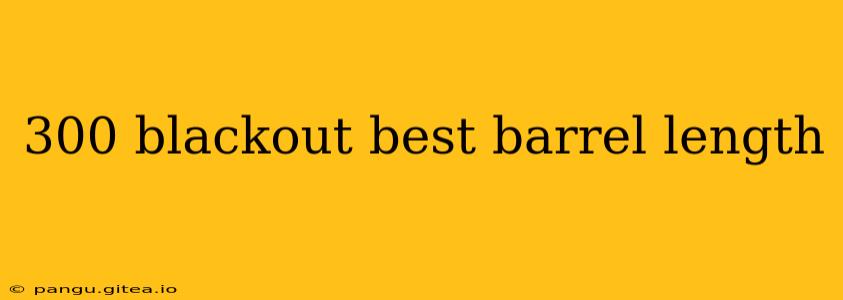Choosing the right barrel length for your 300 Blackout build is crucial for optimizing performance. The ideal length depends heavily on your intended use – suppressed shooting, hunting, home defense, or general plinking. This guide breaks down the pros and cons of various barrel lengths to help you make the informed decision.
Understanding Barrel Length and 300 Blackout Performance
The 300 Blackout cartridge, known for its versatility, benefits from careful consideration of barrel length. Shorter barrels generally offer increased maneuverability and reduced weight, while longer barrels usually deliver higher velocity and increased accuracy. Let's delve into the specifics:
Factors Affecting Barrel Length Choice:
-
Velocity: Longer barrels allow more complete powder burn, resulting in higher projectile velocity and increased downrange energy. This translates to flatter trajectory and longer effective range, particularly beneficial for hunting or longer-range shooting.
-
Accuracy: While longer barrels generally offer better accuracy, the difference might be negligible in shorter ranges for some applications. Proper barrel construction and ammunition choice play a significant role here.
-
Sound Suppression: Shorter barrels are often preferred with suppressors. A shorter barrel length paired with a suppressor can help reduce overall length and increase maneuverability in close-quarters situations.
-
Weight and Maneuverability: Shorter barrels result in a lighter and more compact firearm, ideal for home defense, close-quarters combat (CQB), or when mobility is paramount.
Popular Barrel Length Options and Their Applications:
7-8 inch Barrels:
- Pros: Extremely compact and lightweight, ideal for suppressed use in close-quarters scenarios, excellent for home defense.
- Cons: Significant velocity loss compared to longer barrels; reduced effective range; potential for increased back pressure and higher recoil with unsuppressed use. Best suited for subsonic ammunition.
9-10 inch Barrels:
- Pros: A good compromise between compactness and velocity; manageable recoil, suitable for suppressed and unsuppressed use; good balance between maneuverability and range.
- Cons: Still relatively short, resulting in some velocity loss compared to longer barrels.
11-16 inch Barrels:
- Pros: A significant improvement in velocity compared to shorter barrels; better accuracy potential; suitable for various applications, including hunting smaller game and longer-range shooting.
- Cons: Less maneuverable than shorter barrels; may still benefit from a suppressor, especially at higher velocities.
16+ inch Barrels:
- Pros: Maximum velocity and accuracy potential for the 300 Blackout cartridge; ideal for hunting larger game and longer-range shooting; less affected by suppressor backpressure.
- Cons: Heavier and less maneuverable; less suitable for CQB or home defense scenarios.
Choosing the Right Barrel Length for You:
Ultimately, the "best" barrel length is subjective and depends on your specific needs and intended use. Consider these questions:
- What is your primary purpose for owning a 300 Blackout firearm? Home defense? Hunting? Long-range shooting?
- Will you be using a suppressor? If so, a shorter barrel might be preferable.
- What level of maneuverability is important to you?
- What is your acceptable trade-off between velocity/accuracy and weight/maneuverability?
By carefully considering these factors, you can select the 300 Blackout barrel length that best suits your individual requirements and enhances your shooting experience. Remember to consult with firearms experts and always practice safe firearm handling techniques.
